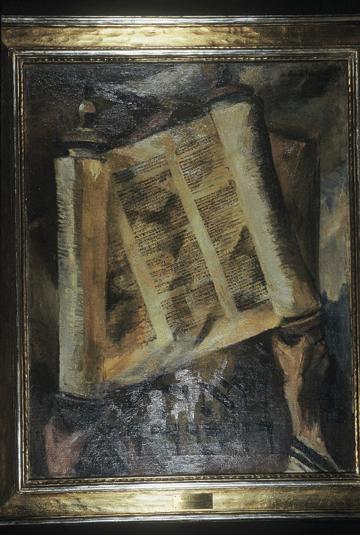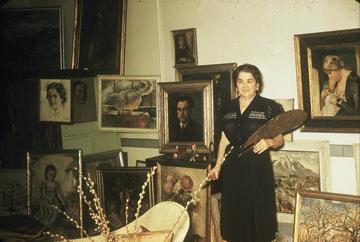
Former Kansas Citian Carol Terte Gill is writing a book about her great aunt, artist Paula Neufeld, whose many works still hang in the homes of prominent Kansas City residents. In the process, she’d would like to locate one of her aunt’s missing paintings. {mprestriction ids="1,3"}She contacted The Chronicle hoping an article would assist in the search.
“One of Paula Neufeld’s most famous paintings, titled ‘This Is the Law’ has disappeared somewhere in Kansas City. It is my quest to find it,” said Gill, who attended Southwest High School and now lives in in Cleveland Heights, Ohio.
Neufeld was born in Poland, studied art in Germany and was driven away by the Nazis in the 1930s. Among the oil paintings the artist brought with her was the critically acclaimed “Dies ist die Lehre!” (“This is the Law”). In 1940 it was donated to The Temple, Congregation B’nai Jehudah by Sol Friedman, Neufeld’s brother-in-law and Gill’s grandfather, in memory of his wife, Adele.
That painting was awarded critical acclaim in a 1935 exhibition at the Jewish Museum in Berlin. This dramatic image depicts two strong hands holding high the Torah. Gill said Dr. Max Osborn, a notable German art critic and historian of the time, raved about the painting.
“With exceedingly fine tact, reality and symbol are blended to give shape to this extraordinary pictorial theme, which leaves a profound expression. We can imagine seeing below the hands holding the ‘Law’ aloft — arms belonging to a human form filled with religious fervor, the strong upward movement assuming a general expression of confession of faith in this traditional act, which the ‘Raising of the Torah’ signifies. The delicate colors and bright light harmoniously blended by the artist show the holy scroll as an exalted symbol. It is one of the most beautiful paintings with an emphasized Jewish theme that has been created within the last few years,” the art critic commented.
Neufeld died in 1967 at the age of 83. Forty-seven years after the artist’s death, her niece is searching for material for a family book about the artist’s life and career.
“I want to include personal recollections, memorabilia and photographs to be shared with those who have admired her art, or who simply wish to learn about this gifted Kansas City artist,” she said.
Neufeld was born in 1884 in Pozen, which at that time was the capital of Prussian Poland. She was the youngest of eight children of Samuel Neufeld, an Orthodox cantor, and Dorothea Norden Neufeld. She moved to Berlin at an early age to attend the Berlin Academy of Art.
According to Gill, Neufeld, like many art students of that day, spent long hours in the Kaiser Friedrick Museum copying the old masters. Her work came to the attention of Freiherr von Koenig, a prominent artist who invited her to study with him, followed by instruction under other renowned German artists and teachers of the day.
“Paula traveled widely, painting landscapes of Italy, Switzerland and the Scandinavian countries and developed a special interest in capturing on canvas and in sketchbooks the dedication and pioneer spirit of Jewish youth on a training farm in Germany for young Zionists. As her reputation spread, she became one of Germany’s most promising women artists, exhibiting in museums in Berlin, Mannheim, Breslau, Stuttgart and London,” Gill explained.
Gill said her aunt’s growing artistic success was cut short by the rise of Nazism.
“She received a chilling official letter in 1935 in response to her application for admission to the Reichskammer der Bildenden Kunste (Reich Authority for the Fine Arts). The letter stated, ‘I hereby refuse your request ... since, as a non-Aryan, you cannot be responsible or qualified for the creation of German cultural works. I hereby forbid you to be further active as a painter and graphic designer.’ This letter fortuitously provided the catalyst for her immigration to America,” Gill said.

In 1936 Neufeld arrived in Kansas City where she joined her sister, Adele Friedman, who had immigrated to America as a bride in 1895. Adele had come to Kansas City to be near her daughter, Irene, who was married to Judge Ben Terte, a prominent circuit court judge in Kansas City. The Tertes are Gill’s parents.
“My parents welcomed Paula into our family where she became a constant and important part of my childhood,” Gill said.
Gill said during Neufeld’s years in Kansas City, she painted landscapes, still lifes, murals and commissioned portraits. Several of her paintings were exhibited at The William Rockhill Nelson Gallery of Art, the St. Louis Art Museum, the Denver Art Museum, the Kansas City Art Institute, the Kansas City Jewish Community Center and the popular Lawrence Art Gallery.
Among the items Gill has accumulated for her book about Neufeld is an “eloquent letter of acceptance from H.M. Helzberg,” who was the president of B’nai Jehudah when the painting was donated to the Reform congregation.
It states, “The subject is fundamental to Jewish life and I am sure it will prove an inspiration to all who see it. The congregation will cherish it and will protect it with great care.”
Gill believes the painting hung in B’nai Jehudah’s original building on Linwood Boulevard and later in its location on Holmes Road. Gill first noticed that the painting was missing on a visit to B’nai Jehudah in the early 1990s.
“My attempts to locate it at that time were unsuccessful, and I discontinued my search until recently when I began writing my book about this remarkable woman,” said Gill. “I have resumed my quest to locate this very significant work of art. In spite of the kind cooperation of the Temple’s administrative staff, there is no indication of where this painting might be found. Repeated inquiries have proved futile.”
Gill is looking for anyone who may have a clue as to the painting’s whereabouts. She may be contacted via email at
In addition to the missing painting, Gill is seeking the names of those who own works by Neufeld that might be reproduced in the book she is writing.
“My great aunt, my Tante Paula, was as beautiful and charming as the art she created. She possessed the aesthetic sensibility of an artist, seeing beauty in the commonplace along with a warmth and ingenuous quality that was endearing. The collection of her paintings that now hang in my home in Cleveland are a constant reminder of this loving and charming woman.”{/mprestriction}



